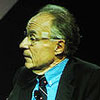
Biografia estratta da Nobel Lectures, Physics 1971-1980.
![]() 1978 Premio Nobel per la Fisica
1978 Premio Nobel per la Fisica
(1936- vivente)
Arno Allan Penzias nacque a Monaco di Baviera il 26 aprile 1933. Nel 1940 la sua famiglia si trasferì negli Stati Uniti per sfuggire alle persecuzioni antisemite della Germania Nazista, e nel 1946 Penzias divenne cittadino americano.
Si laureò in fisica nel 1954 presso il City College di New York. Quindi divenne assistente al Radiation Laboratory della Columbia University, dove si occupò di fisica delle microonde, lavorando insieme a Charles Townes, il futuro inventore del maser, ed ottenendo il dottorato nel 1962.
Successivamente venne assunto ai Bell Telephone Laboratories di Holmdel, in New Jersey, dove, insieme a Robert Wilson, si occupò dello sviluppo di ricevitori di microonde criogenici ad altissima sensibilità per osservazioni radioastronomiche. Nel 1964 misero in funzione la loro antenna più sensibile, lunga 15 metri, che iniziò a ricevere un segnale radio molto debole e isotropo che non riuscirono inizialmente a spiegare. Esclusero il rumore radio proveniente da New York o qualche sorgente astronomica, poiché non isotropi. All’interno del corno dell’antenna trovarono del guano di piccione, che Penzias descrisse nei suoi appunti come “materiale bianco dielettrico”, ma anche dopo averlo rimosso il fondo rimase. Dopo aver scartato tutte le sorgenti di rumore, i due contattarono l’astronomo Robert Dicke, il quale suggerì che potesse trattarsi della radiazione di fondo predetta da alcune teorie cosmologiche. Pubblicarono quindi 2 articoli in contemporanea su Astrophysical Journal, uno firmato da Penzias e Wilson riguardo le osservazioni sperimentali e uno firmato da Dicke riguardo l’interpretazione del segnale come Radiazione Cosmica di Fondo a microonde (CMB), il residuo della radiazione del Big Bang.
Nel 1978 Penzias e Wilson ricevettero il premio Nobel per la fisica per la loro scoperta, considerata oggi una delle prove più valide della teoria del Big Bang.
Arno Penzias vive tuttora nel New Jersey.

